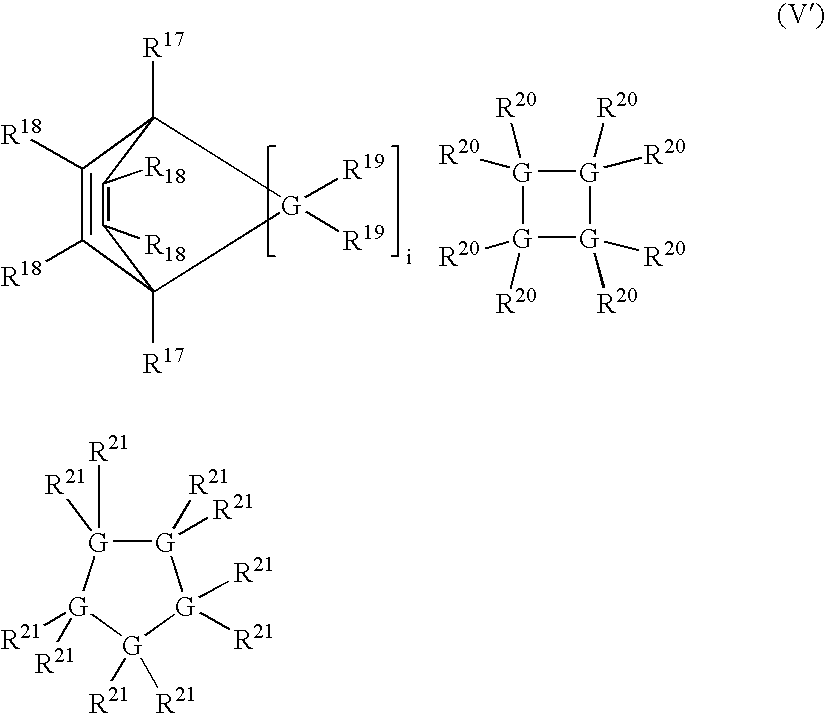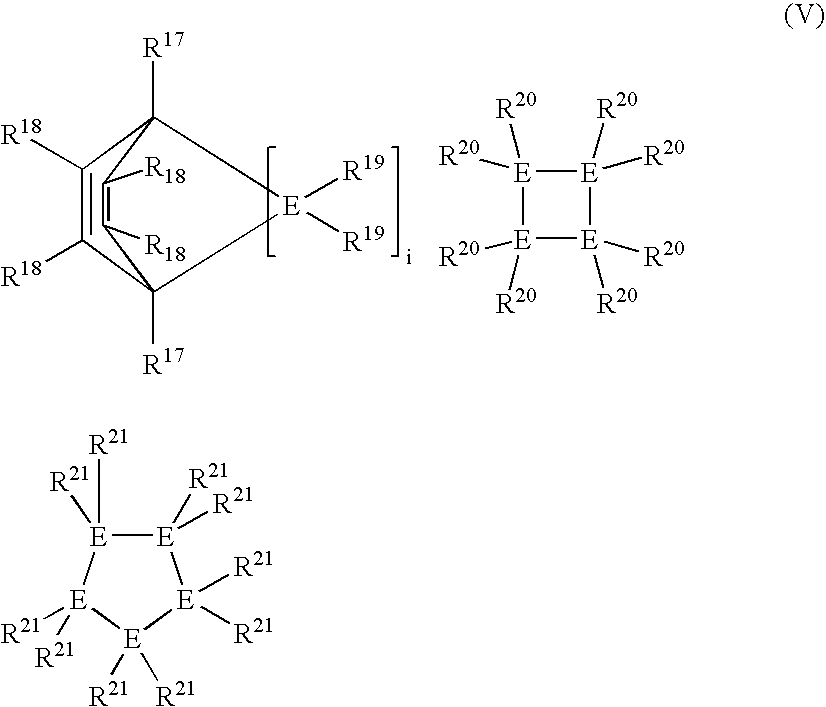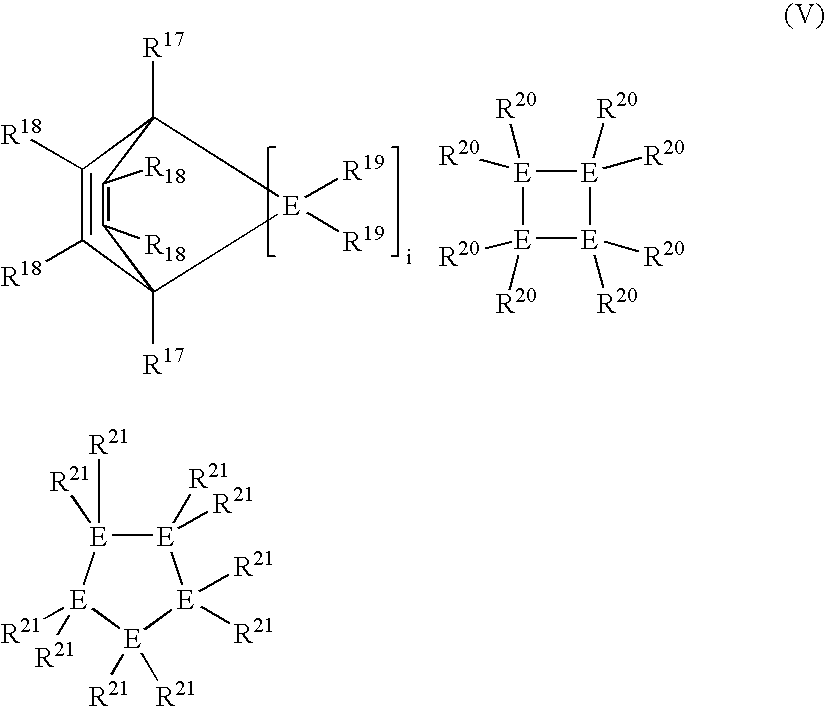Linear and cross-linked high molecular weight polysilanes, polygermanes, and copolymers thereof, compositions containing the same, and methods of making and using such compounds and compositions
a polygermane and polysilane technology, applied in the field of polygermane compounds, compositions and methods of making and using the same, can solve the problems of large toxic waste, complex three-dimensional structures, and a multitude of expensive machines
- Summary
- Abstract
- Description
- Claims
- Application Information
AI Technical Summary
Benefits of technology
Problems solved by technology
Method used
Image
Examples
example 1
[0137] Synthesis of polyphenylsilane from Ph2SiBr2 and Br2PhSi—SiPh2-SiPhBr2 at 65 DEG C. In a glovebox, a 1 L Schlenk flask is loaded with 215 mmol of Na metal and 100 mL of toluene. The mixture is heated to reflux and stirred to produce a fine suspension of Na in toluene. The suspension is chilled to room temperature and transferred to an addition funnel. A 1 L Schlenk flask is loaded with 95 mmol of Ph2SiBr2, 5 mmol of Br2PhSi—SiPh2-SiPhBr2, 10 mL of diglyme, and 100 mL of toluene (Br2PhSi—SiPh2-SiPhBr2 is synthesized as described by Hassler et al., “Synthese einiger Phenylbrom- und Phenyliod-disilane und -trisilane,”J. Organomet. Chem., 385: 201-206 (1990)), incorporated herein by reference. The temperature of the mixture is brought to 65 DEG C. and a suspension of Na in toluene is added slowly over a period of 10 minutes. After the addition of the monomer, the mixture is stirred at 65 DEG C. for 4-5 h and allowed to cool to room temperature and stirred overnight. Isopropanol is...
example 2
[0138] Synthesis of polyphenylsilane from Ph2SiBr2 and Br2PhSi—SiPh2-SiPhBr2 using ultrasonic activation In a glovebox, a 1 L Schlenk flask equipped with a sonicator probe is loaded with 215 mmol of Na metal and 100 mL of toluene. The mixture is sonicated at maximum output without cooling. After approximately 10 min, a fine dispersion is produced. The suspension is chilled to room temperature and transferred to an addition funnel. A 1 L Schlenk flask equipped with a sonicator probe is loaded with 95 mmol of Ph2SiBr2, 5 mmol of Br2PhSi—SiPh2-SiPhBr2, 10 mL of diglyme, and 100 mL of toluene (Br2PhSi—SiPh2-SiPhBr2 is synthesized as described by Hassler et al., “Synthese einiger Phenylbrom- und Phenyliod-disilane und -trisilane,”J. Organomet. Chem., 385: 201-206 (1990)), incorporated herein by reference. The flask is cooled in an ice bath and sonicated at 60% of maximum output (resulting in a reaction temperature of ca. 25 DEG C.). A suspension of Na in toluene is added slowly over a pe...
example 3
[0139] Synthesis of polyphenylsilane from Ph2SiBr2 and Br2PhSi—SiPh2-SiPhBr2 using electroreduction In a glovebox, a 1 L undivided electrochemical cell with Mg rod anode and cathode and a sonicator probe is loaded with 20 mmol of NH4ClO4, 95 mmol of Ph2SiBr2, 5 mmol of Br2PhSi—SiPh2-SiPhBr2, and 100 mL of dimethoxyethane (Br2PhSi—SiPh2-SiPhBr2 is synthesized as described by Hassler et al., “Synthese einiger Phenylbrom- und Phenyliod-disilane und -trisilane,”J. Organomet. Chem., 385: 201-206 (1990)), incorporated herein by reference. Electroreduction is carried out by passing 0.21 F of electricity through the solution over a period of 3 h. The anode and cathode are alternated at an interval of 15 s, and sonication is applied continuously. The polymer is precipitated with 500 mL of isopropanol. The solid is filtered out, dried in vacuum, and extracted into 500 mL of warm (40 DEG C.) toluene. The toluene solution is washed with water and filtered through Celite. The solvent is removed ...
PUM
 Login to View More
Login to View More Abstract
Description
Claims
Application Information
 Login to View More
Login to View More - R&D
- Intellectual Property
- Life Sciences
- Materials
- Tech Scout
- Unparalleled Data Quality
- Higher Quality Content
- 60% Fewer Hallucinations
Browse by: Latest US Patents, China's latest patents, Technical Efficacy Thesaurus, Application Domain, Technology Topic, Popular Technical Reports.
© 2025 PatSnap. All rights reserved.Legal|Privacy policy|Modern Slavery Act Transparency Statement|Sitemap|About US| Contact US: help@patsnap.com



